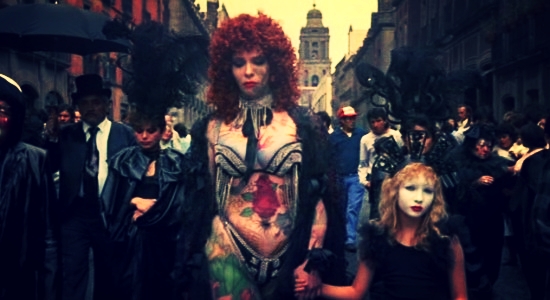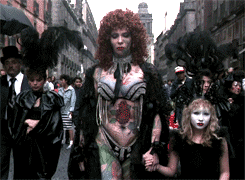BY MONIQUE QUINTANA
For years, I have been too frightened to watch Alejandro Jodorowsky's film Santa Sangre. I suppose I was afraid that I would not understand it, that it would be too avant-garde for me, that I wouldn’t appreciate it or that I would think it was what some of my family members call ridiculous bendejo art. I watched the film two nights ago, and I am still reeling from the immense beauty of it. I find it grotesquely beautiful. I was visually and emotionally gutted. The film is about a young boy, Fenix, who grows up in a Mexican circus and is institutionalized after he endures his mother's dismemberment at the hands of his father and his father’s public suicide by self-mutilation.
The three most developed female characters in the film are a trinity of feminine beauty, and their aesthetics speak to the way men perceive female bodies and the female body politic. The main character’s mother, Concha, is a trapeze and aerial artist and cult leader who is dismembered by her own husband, whom she is very much in love with. Her armless body is the echo of the patron saint that she idolizes and also conjures the dismembered body Lavinia of Shakespeare’s play Titus Andronicus. At the core of all these crimes is sex. Concha is triggered when she sees her husband having sex with another woman, and her idol, Santa Sangre, had been raped by two men in the street. When their arms are severed, they are literally marked bodies.
RELATED: Strange Beauty: Chavela Vargas
Via Fandor
The tattooed women that Fenix’s father has an affair with is a further example of a woman’s body as spectacle. Her body is lusted after, but is also abhorred, as she is the impetus of her lover's misery and eventual demise. Her tattooed body is performing outside of gender expectations. Her body is an "exotic" thing that cannot rest within the boundaries of appropriateness. When her body appears, there is often intense music, the kind of music that two people would like to dance to. When she is mutilated, the music plays furiously again.
Via the Quietus
The white painted face of Fenix’s childhood love, Alma, is clown-like, death-like, doll-like, and angel-like, conjuring fairy tales of beautiful dead women in castle towers and glass castles, the poetical beauty by the sea that Poe spoke about in "Annabelle Lee." Yet, Alma is not the sanitized woman. She is a woman that was sexually abused, but ultimately finds autonomy after death has consumed much in her life.
Via Sins of Cinema
Concha, The Tattooed Woman, and Alma are three female bodies that are connected through the violence and misogyny that the toxic masculinity in their society projects on their bodies. They spin on a wheel in the film, each one's experience informing the lives of the others, all the while relaying an individual's stake in love and sexual relationships with men, all the while asking the audience, What is the female body? Are we only here to amuse you?
Via Giphy
Monique Quintana is the Senior Beauty Editor at Luna Luna and a contributor at Clash Media. She holds an MFA in Creative Writing Fiction from CSU Fresno and her work has appeared in Huizache, Bordersenses, The Acentos Review, and Storyscape, among other publicatons. She is a Best of the Net Nominee, a fellow of the Community of Writers at Squaw Valley, and an alumn of the Sundress Academy of the Arts. She teaches English in the Central Valley, "the other California."



































